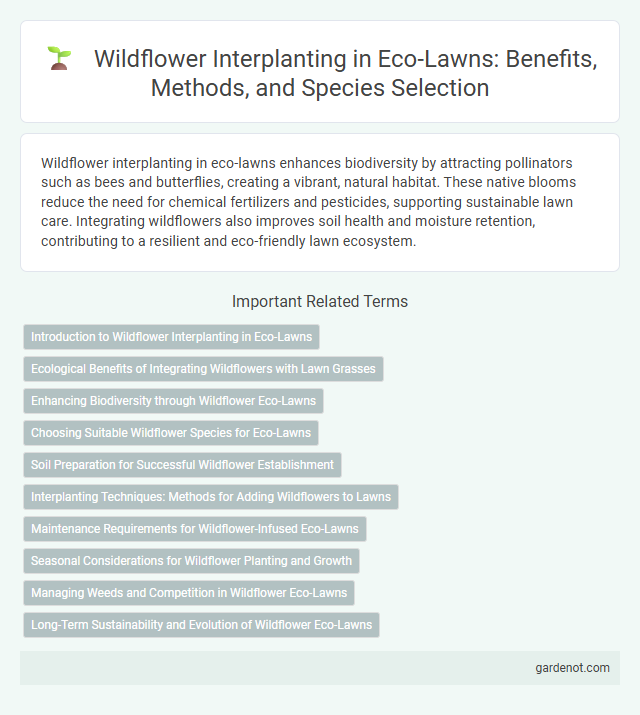Wildflower interplanting in eco-lawns enhances biodiversity by attracting pollinators such as bees and butterflies, creating a vibrant, natural habitat. These native blooms reduce the need for chemical fertilizers and pesticides, supporting sustainable lawn care. Integrating wildflowers also improves soil health and moisture retention, contributing to a resilient and eco-friendly lawn ecosystem.
Introduction to Wildflower Interplanting in Eco-Lawns
Wildflower interplanting in eco-lawns enhances biodiversity by integrating native wildflower species with traditional grass varieties. This approach supports pollinators, improves soil health, and reduces the need for synthetic fertilizers and pesticides. Selecting regionally adapted wildflowers ensures sustainability and creates vibrant, resilient landscapes that thrive with minimal maintenance.
Ecological Benefits of Integrating Wildflowers with Lawn Grasses
Integrating wildflowers with lawn grasses enhances biodiversity by providing essential habitats and nectar sources for pollinators such as bees and butterflies. This ecological interplanting improves soil health through diverse root structures that promote aeration and nutrient cycling. Wildflower interplanting also increases the lawn's resilience to pests and drought, reducing the need for chemical fertilizers and irrigation.
Enhancing Biodiversity through Wildflower Eco-Lawns
Wildflower interplanting in eco-lawns significantly enhances biodiversity by providing diverse habitats and food sources for pollinators, birds, and beneficial insects. Incorporating native wildflower species increases ecological resilience and supports local ecosystems, promoting natural pest control and soil health. These wildflower-rich lawns create vibrant, sustainable environments that contribute to urban green space restoration and biodiversity conservation.
Choosing Suitable Wildflower Species for Eco-Lawns
Selecting wildflower species that thrive in eco-lawns requires prioritizing native, drought-tolerant, and low-maintenance varieties such as clover, yarrow, and prairie smoke. These species enhance biodiversity, support pollinators, and improve soil health while maintaining a balanced ecosystem. Incorporating a diverse mix ensures seasonal blooms and resilience against pests and diseases.
Soil Preparation for Successful Wildflower Establishment
Soil preparation for wildflower interplant in eco-lawns involves deep tilling and removing debris to create a loose, well-drained seedbed that promotes root development. Testing soil pH and amending it to a slightly acidic to neutral range (6.0-7.0) ensures optimal nutrient availability for wildflower seeds. Incorporating organic matter like compost improves soil fertility, moisture retention, and supports beneficial microbial activity essential for successful wildflower establishment.
Interplanting Techniques: Methods for Adding Wildflowers to Lawns
Interplanting wildflowers into eco-lawns involves techniques such as overseeding with a mix of native wildflower seeds tailored to local soil and climate conditions. Methods include preparing the soil by aeration, selecting bloom periods that complement existing grass growth, and using seed drills or hand broadcasting for even distribution. Proper timing in early spring or fall ensures optimal germination and integration, promoting biodiversity and reduced lawn maintenance.
Maintenance Requirements for Wildflower-Infused Eco-Lawns
Wildflower interplanting in eco-lawns significantly reduces mowing frequency, requiring only light trimming to maintain aesthetics and plant health. Native wildflower species demand minimal irrigation and are naturally resistant to pests, lowering overall maintenance costs. Proper seasonal management includes selective weeding to prevent invasive species and occasional reseeding to sustain biodiversity and vibrant floral display.
Seasonal Considerations for Wildflower Planting and Growth
Wildflower interplanting in eco-lawns requires careful attention to seasonal considerations to ensure optimal growth and bloom cycles. Early spring is ideal for sowing most wildflower seeds as soil temperatures rise, promoting germination and establishment before summer heat stress. Selecting native species adapted to local climate patterns enhances resilience and supports pollinator activity throughout different seasons.
Managing Weeds and Competition in Wildflower Eco-Lawns
Wildflower interplanting in eco-lawns enhances biodiversity while naturally suppressing weeds through dense plant coverage and root competition. Selecting native wildflower species with varying bloom times and growth habits optimizes space usage, reducing opportunities for invasive weeds to establish. Regular monitoring and targeted hand weeding during initial growth phases ensure the balance between wildflowers and unwanted plants is maintained effectively.
Long-Term Sustainability and Evolution of Wildflower Eco-Lawns
Wildflower interplant in eco-lawns promotes long-term sustainability by enhancing biodiversity and supporting pollinator habitats, which are crucial for ecological balance. This method facilitates natural succession and resilience, allowing the wildflower species to evolve alongside environmental changes and maintain soil health. Over time, the dynamic composition of wildflower eco-lawns creates a self-sustaining ecosystem that reduces the need for fertilizers, pesticides, and frequent mowing.
Wildflower interplant Infographic

 gardenot.com
gardenot.com